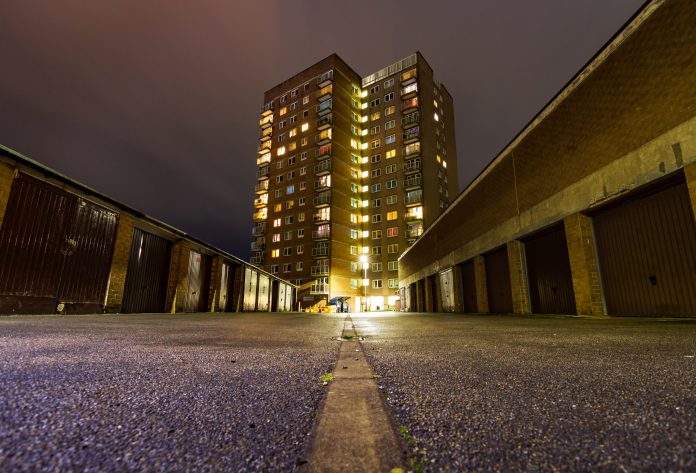Derek Horrocks, owner of specialist retrofit decarbonisation turnkey provider Sustainable Building Services (UK) Ltd, discusses why the real-life benefits of social housing decarbonisation cannot be underestimated
A key step in addressing climate change is social housing decarbonisation. However, the wider real-life benefits for residents, communities and society are felt most acutely within the social housing sector, and work towards creating a levelled-up country too.
There are some 29m domestic properties across the UK, with a huge majority of these requiring significant energy efficiency and microgeneration improvements. Roughly 4.5m of these properties are social homes in England – a number that increased by 31,000 last year alone.
Landlords are eager – and in many ways already are – leading the way on social housing decarbonisation, seeking to tackle the climate emergency and ongoing energy crisis. However, it’s important not to neglect the other widespread social benefits that can be achieved while tackling these key aims – all of which will benefit the millions of people living in their properties.
Home upgrades improve the physical health of residents
Home upgrades don’t just lower emissions – they have a real positive impact on people and society in many ways often under considered next to net zero goals. The health benefits are not limited to short-term avoidance of winter bugs in the colder months, but longer-term too including better management of chronic conditions.
For example, better thermal comfort through heating and insulation upgrades can keep homes warmer in the winter, but also cooler in the summer – and with climate change seeing us having to cope with hotter weather year-on-year, this reduces the risk of heat exhaustion.
Elsewhere, improved air quality in homes reduces the exposure to pollutants, creating lower risk and easier management of respiratory problems like asthma.
Better levels of overall health mean fewer lost school or workdays, allowing people to maximise the opportunities afforded to them, while wider society and the economy benefits from higher levels of productivity too. Plus, people living healthier lives will mean lower pressure on the NHS, reducing the current escalating high demand on every service area.
Boosting mental health amongst some of the most vulnerable members of society
Equally, the mental tax of living in poor housing is evident. The first and most obvious point being that higher-quality homes are comfortable, feel safer and are more pleasant to inhabit, leading to happier residents.
However, social housing is often home to vulnerable and lower-income households, who are disproportionately impacted by the current energy crisis and fuel poverty. Research carried out by the National Housing Federation in late 2022 revealed that social renters in the most inefficient homes were having to spend 15.5% of their income on heating – equivalent to two months’ salary.
The same report showed that more than half of social homes are rated at EPC A, B, or C, but through upgrading those remaining it could save residents upwards of £700m annually in heating costs – equating to a substantial average household saving of 42% or £567.
In simple terms, by upgrading the energy efficiency of homes, the amount of energy required to run them is reduced and means lower bills for tenants. There is no question that this will promote better wellbeing in residents, reducing the financial burden and stress.
Again, this creates a snowball effect. Improved wellbeing means less pressure on those resources within the NHS, reducing overall waiting times for support. It also means fewer days taken as sick leave – which according to the Labour Force Survey averaged at 18.6 days for stress, depression or anxiety in 2021/22. And in turn, this means lower levels of wage loss for earners and more money back in their accounts as a result.
Providers must maximise social housing decarbonisation funding potential
With the second wave of funding through the Social Housing Decarbonisation Fund – valued at £800m – set to be announced imminently, registered social housing providers need to be ready to maximise on the opportunity that comes with funding and mobilise as quickly as possible.
Whether successful or not, housing providers must be considering their options, seeking the suppliers best positioned to provide end-to-end solutions in order to streamline processes – and budgets. For those projects being funded by the Social Housing Decarbonisation Fund, all installers are required to be Trustmark registered and work must be delivered to PAS 2035:2019.
It’s important that all stakeholders know the expected outcomes and have a clear, team-wide idea of how those outcomes will be achieved from the earliest possible point. This is key to ensuring that budgets are used effectively and that the maximum number of residents benefit from the works.
Too often, since the introduction of the new PAS standards, a lack of clarity on the part of inexperienced stakeholder teams has led to an under-estimation of costs and timescales. This is because the groups involved haven’t been familiar with the demands of the process, nor how to deliver multiple measures in a timely and efficient way. As a result, costs can escalate, and the number of treated properties has to be reduced.
A cohesive approach to social housing decarbonisation is needed to deliver net zero
Critically, the early engagement must include residents. A ‘right first time’ approach is, of course, needed to minimise any disruption to people, but as the work we carry out is on their homes, we must make sure they know what will happen and when – but mostly the ways in which it will benefit them.
Local authorities and housing associations essentially have a golden opportunity in front of them. Instead of just improving the energy efficiency of their building stock, they are able to take the unique step of combining numerous benefits in one swoop, which work to achieve net zero, making homes safer and improving people’s quality of life together.

Plus, a highly skilled retrofit and maintenance ‘green’ workforce is needed. This is a fast-emerging sector that provides huge opportunity for job creation through new practices, processes and innovation along with the physical delivery of decarbonisation schemes.
The message is clear; one coordinated approach to work towards solving a multitude of the UK’s biggest challenges. It’s up to the emerging specialist supply chain and housing providers to collaborate and make it a reality.








![[VIDEO] Making DorTrak reports easy to read with Fireco Inspecting fire doors at Fireco, firedoor technology, 2023](https://www.pbctoday.co.uk/news/wp-content/uploads/2024/04/JPZ_2364-web-218x150.jpg)
![[VIDEO] Re-flow Field Management review by Traffic Management Installations When TMI began subcontracting for councils and government bodies, they wanted to present their site reporting in a more professional manner](https://www.pbctoday.co.uk/news/wp-content/uploads/2025/03/TMI-Media-1-218x150.png)




